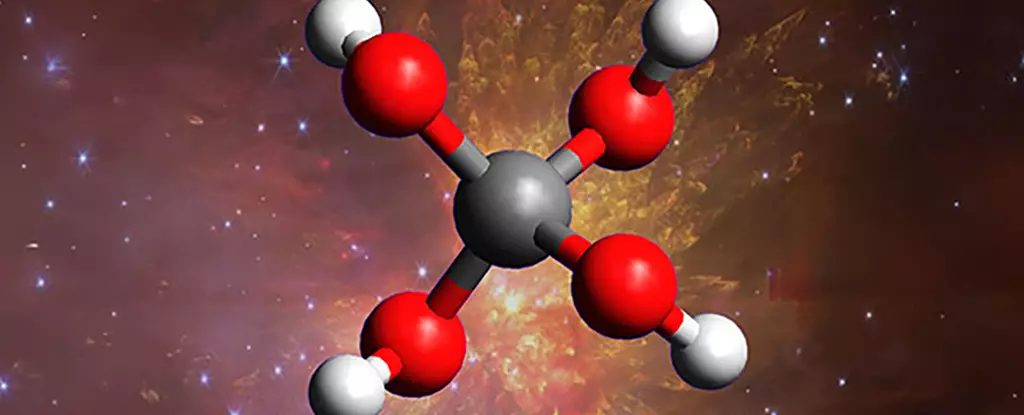For decades, the vastness of space was believed to be a barren, chemically primitive environment, dominated by simple molecules and basic hydrogen compounds. However, recent experiments shake this assumption to its core, unveiling a realm of complex and counterintuitive chemistry that defies terrestrial intuition. The accidental discovery of methanetetrol—a molecule previously consigned to theoretical realms—demonstrates how our understanding of interstellar chemistry is fundamentally incomplete and perhaps even naive. It underscores an unsettling truth: our planet-bound perspective skews our perception of the universe’s potential, leading us to underestimate the diversity and resilience of cosmic molecular processes.
This revelation extends well beyond just confirming long-held scientific predictions; it challenges the very framework through which we interpret space chemistry. The creation of methanetetrol in laboratory simulations illustrates that conditions supposedly too extreme or unstable to support complex molecules may, in fact, foster the synthesis of molecules that seem almost impossible—if not outright absurd—from an Earth-based viewpoint. By pushing the boundaries of known chemistry, scientists compel us to consider that the universe might be a far more chemically vibrant and active environment than previously imagined, fueling a reconsideration of extraterrestrial habitability and the origin of life itself.
The Unseen Complexity of Interstellar Space
The discovery was not accidental but the result of meticulous simulation: replicating the frigid, vacuumed depths where stars seed the cosmic dust with molecules that could eventually coalesce into planets and, potentially, life. The process involved freezing cosmic-like ice, bombarding it with high-energy radiation, and observing the resulting chemical reactions—an elaborate dance of physics and chemistry carried out in our labs, yet eerily reminiscent of space’s own chaotic ballet.
What makes this breakthrough revolutionary is that methanetetrol defies expectations about molecular stability. It rapidly dissociates when exposed to light or external energy sources, making its detection in space a daunting challenge. Despite these difficulties, the very presence of such a molecule hints at a profound truth: the interstellar medium is a hotbed of complex, dynamic chemistry that often occurs in ways we remain far from fully understanding. Each new molecule found complicates the previous models, exposing gaps that threaten to render our current theories inadequate. This molecule’s fleeting existence under earthly conditions only magnifies its importance in space, where the cold, radiation-rich environment may provide the only context for its formation and stability.
Furthermore, the evidence points to the fact that space chemistry is more elaborate and vigorous than traditional models suggest. The discovery aligns with a growing body of research indicating that cosmic conditions can produce molecules that on Earth would be considered impossible, unstable, or outright dangerous. In this light, space appears as an unending laboratory of molecular innovation—one that challenges the conservative assumptions often embedded in mainstream scientific thought.
Implications for Humanity’s Quest to Understand the Cosmos
This breakthrough holds profound implications for the quest to understand whether life exists elsewhere or how it might originate. The existence of complicated molecules like methanetetrol raises the tantalizing possibility that the universe’s chemistry is inherently more conducive to producing the building blocks of life than previously assumed. Instead of the universe being a sterile vacuum punctuated by occasional planets, it may be a bubbling cauldron of molecular complexity, capable of generating life’s precursors in unexpected places.
Yet, despite the excitement, we must confront the limitations of our current technological arsenal. Detecting methanetetrol in the depths of space is a formidable challenge because of its transient nature—it disintegrates rapidly when exposed to sunlight or cosmic radiation. Our telescopes and detection methods are just beginning to scratch the surface of cosmic chemistry, revealing only fragmentary glimpses into this vast molecular zoo. The pursuit to identify such molecules in their natural habitats is a race against their fleeting existence, a scientific treasure hunt that pushes the limits of what our current technology can achieve.
Moreover, this discovery urges a shift in scientific philosophy. Instead of dismissing certain molecules as “impossible” or too unstable to exist naturally, we should approach cosmic chemistry with openness and curiosity. The universe has repeatedly demonstrated that nature often operates in ways that challenge our understanding, and clinging to Earth-centric assumptions may blind us to its true scope. Embracing this complexity—acknowledging that chemistry in space is likely far richer than on Earth—is essential for advancing our knowledge.
As we refine our instruments and improve our theoretical models, each breakthrough like methanetetrol reminds us how much remains undiscovered. The universe’s molecular landscape is far from exhausted, and each new discovery erodes the long-held beliefs of scientific conservatism. Space, in its vastness and harshness, paradoxically emerges as one of the most fertile grounds for chemical and possibly biological innovation—if only we are willing to look beyond our terrestrial biases.


Leave a Reply